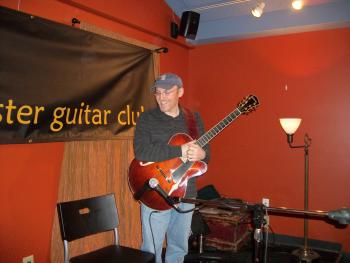Bob Sneider's Presentation on “Fretboard Harmony through the Eyes and Ears of a Jazz Player” on November 15, 2010

Bob Sneider
Bob Sneider warmed up his Eastman archtop, with this thought, “How does a jazzer harmonize a melody?” Let’s start by listening to some of the players who have influenced Bob: Barney Kessel, George Van Eps, Hank Garland, Wes Montgomery, Tal Farlow, Joe Pass and Johnny Smith. Each of them demonstrates “chord/melody” or “chord/solos.”. Each of them is equally capable of playing this style “rubato” and “in time.”
Bob demonstrated a harmonized melody with Hoagy Carmichael’s “Stardust.” So what is this style of playing? The melody, with an appropriately chosen chord placed below it. There may be diatonic chords (chords found in the scale), altered diatonic chords (a Major add 6 in place of a major triad), or a substitution. (tritone or some other variation) If a guitarist is working alone, then bass notes take on added importance, and chords may have the melody on top with the root at the bottom. But if you are working with a bass player or a rhythm section, then voice the chords without the root at the bottom, because the bass player will cover it. And don’t forget that the guitar is a transposing instrument sounding an octave lower than written.
Remember the first chords you learned down in the first three or four frets? These voicings often double (or even triple!) the root. They are too thick for “chord/melody” style and also lack interest. Some of these double the fifth as well. Instead, voice the chords for the sound and also for movement (voice leading) from one chord to the next.
Bob demonstrates this with 1-2-3-5, 1-2-3-5 chords up the neck before passing out an arrangement of “In My Life” (Lennon/McCartney) in chord/melody style. He began by playing the melody alone, single line. Then he played the same melody with basic chords and finally with “jazz” chords. Bob also noted that this style of playing is easier to achieve with finger style than it is using a pick. The chords can be played as a block or may be“rolled.”
Bob further illustrates his points with the standard songs “How Deep is the Ocean” (Irving Berlin) and “You’ll Never Know.” (Gorden/Warren). Another tip is to keep the melody strong. The harmony does not have to be overly complex. In fact, if you make it too complicated, listeners may not know what you just played. Bob showed us this, with an overly “outside” version of “In My Life.” (taken too far…) Remember, choose harmony that fits the character of the song.
Some books that Bob recommends are Barry Galbraith’s “Chord Melody,” (Mel Bay) Wes Montgomery’s “Guitar Folio,” Joe Pass’ “Transcriptions,” George Van Eps’ “Guitar Method,” (the first book, not the three-volume set) and especially Eddie Lang’s: “Fretboard Harmony.” (Djangobooks.com) Lang’s book received considerable mention. It is out of print, so look for the download equivalent. Lang’s method was to work on four-note chord voicings using strings 1-4, then 2-5, and finally 3-6. (a 7-string player has even more to work on!) This method opens up the fretboard for many more chord options, and improved voice-leading.
There aren’t any shortcuts. You have to work on melody, arpeggios, harmony, and the song form itself. To “open up” the fretboard, you can also work on scales in intervals of thirds or sixths. Try working on the harmony without the melody, the melody without the harmony and then put the possibilities together. Listen for how it sounds!
Other thoughts from Bob: “I don’t like to have everything worked out in advance; it’s great to be prepared, but spontaneity is a lot of fun.” Also, not every note in the melody needs to be harmonized. In fact, that would usually sound too busy, and compromise the swing and pulse of the song.
If you have ever heard this kind of guitar playing and wanted to try it yourself, this was a comprehensive introduction to the task. Bob, thank you for a great talk and demonstration!
For copies of the handouts, see the Resources page or click here.
—Chuck Dye
Photo: R. Taglieri
Share this page: ![]() Facebook
Facebook
![]() Del.icio.us
Del.icio.us
![]() StumbleUpon
StumbleUpon
![]() Digg
Digg
![]() Reddit
Reddit
Home ::
About Us ::
Events ::
Articles ::
Resources ::
Contact Us ::
Links
©2007-2008, Rochester Guitar Club, All Rights Reserved, This page last updated 2011-03-31 20:19:15
Website by Red Beagle Web Development.








